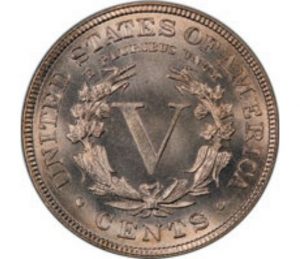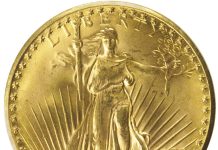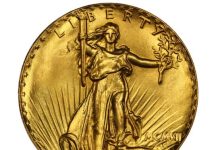
The Professional Coin Grading Service (PCGS) Coin of the Month is the 1885 Liberty Nickel. For whatever reason, the Liberty nickel designed by Charles E. Barber is often overlooked by United States collectors. It’s hard to imagine why, especially as this classic series is anchored by some pretty interesting entries, including the storied 1883 No Cents Liberty nickel that was commonly gold plated by unscrupulous sorts and passed off as $5 gold pieces and the ultra-rare 1913 Liberty nickel, which is believed to have been clandestinely struck and in 1996 became the first individual coin to sell for more than a million dollars.
Then there’s the 1885 Liberty nickel, which isn’t a million-dollar coin but is surely the series key. The 1885 nickel saw a mintage of only 1,472,700 pieces, which is the second-lowest regular-issue mintage in the series after the 1912-S but offers perhaps only 5,000 existing specimens in total across all grades. So few survive because not many were saved from the onset, and the Liberty nickel, which ordinarily saw production outputs of well over 10 million circulated extensively. All specimens of the 1885 Liberty nickel are rare, with even examples grading Good-4 trading for more than $350. One of the nicest specimens of the 1885 Liberty nickel was graded MS66+ by Professional Coin Grading Service and was sold by Heritage Auctions in August 2021 for $11,100.

Coin Grading
Grade refers to a coin’s level of preservation: how many nicks or scratches or other imperfections it has. Coins are graded on a scale of one to 70, with higher numbers signifying higher grades. One represents a coin that is so well worn that it’s barely identifiable as to its type. 70 represents a perfect coin: a coin that when viewed under a five-power magnifying glass has no visible imperfections.
60 through 70 represent the Mint State (MS) grades. A coin graded MS-60 can have so many nicks and scratches and flaws that it might look as if Godzilla used it as a teething ring. MS-65 is the industry standard for “Gem.” MS-66 through MS-69 are the near-flawless super-grade or wonder coin assignations. With each grade level above MS-66, the value might double or triple.
Grade names are used in addition to numerical grades. In ascending order, these word grades are About or Almost Good; Good; Very Good; Fine; Very Fine; Extra or Extremely Fine; About or Almost Uncirculated; and Mint State.
What is a Proof?
A Proof is not a special Mint State coin. Proof refers to a method of manufacture, not a grade. Although Proof coins are struck using specially polished dies and specially selected planchets (metal discs) to assure a chromium-like brilliance, they can circulate or be spent. Proofs are also graded on the one through 70 scale. A Proof coin grading less than Proof-60 is referred to as an “impaired Proof.”
PCGS and the Numismatic Guaranty Company (NGC) are the coin field’s highest-volume authentication and grading services. PCGS and NGC encapsulate coins in sonically-sealed hard plastic holders that are tamper-evident. Most buyers of valuable coins demand only coins that have been certified by leading grading services. These services offer guarantees of authenticity and grade, and their coins often trade sight unseen based on their certified grade.
*Images courtesy of Heritage Auctions, www.HA.com.













